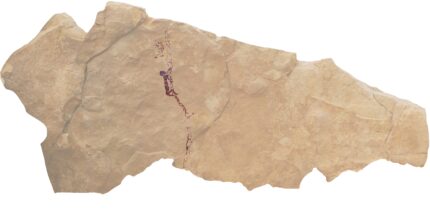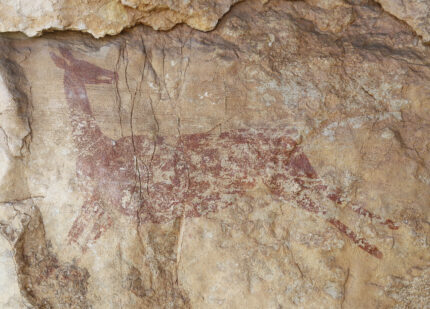Archaeologists have discovered a rare detailed cave painting depicting honey-gathering in Castellote in the Iberian System mountain range of northeastern Spain. Painted in the Levantine (meaning eastern Iberian) art style which is characterized by intricately painted small human and animal figures, the honey collection scene is exceptionally well-preserved, the best-preserved and most detailed of any of its kind in Levantine art. Stylistic classification suggests the honey-gatherer painting is approximately 7,500 years old.
The painting was found in the central section of the Barranco Gómez rock shelter on the banks of the Guadalope River. There are three sets of painting on a wall more than 40 feet wide. Along with the honey gatherer scene are a pair of archers on the hunt and a doe on the run looking backwards.
Honey gathering scenes have been found before in Levantine rock art sites, most famously The Man of Bicorp in the Cuevas de la Araña near Valencia which at 8,000 years of age is the oldest known surviving depiction. While other populations in Europe at this time were farming and growing grains, the hunter-gatherers of eastern Spain had to rely on bee hunting for their sugar fix, and they were willing to pay a steep price, literally. Bicorp Man climbs lianas up a rock face to get his sweet loot from a hive in a crevasse. Barranco Gómez man uses a rope ladder.
[W]e can see the figure of a person, with well-defined facial traits, who climbs up a ladder to reach a beehive. The scene depicts that during the painting period, they used advanced techniques to climb: before going up, the ladder has been fixed at the top, near the beehive, while there is a pole at mid-height to secure the ladder to the rock and provide more stability. […] Both in the hind picture and the scene of the honey extraction feature elements of the same cave in the composition of the painting: the honey harvesting is painted in the wall and the ceiling and it uses both mediums to better represent the scene, while the mouth of the hind is insinuated by leaving a piece of rock unpainted.
The depiction is so detailed that it not only elucidates the honey gathering technology of the period, but also the technique. The gatherer climbs the ladder with outstretched arms and legs, hugging it to minimize swaying.


very cool. wonderful art.
Hi How amazing, I loved this but I also noticed that some of the images looked like women and some like men, it must have been both, maybe a scanned image would show more detail!